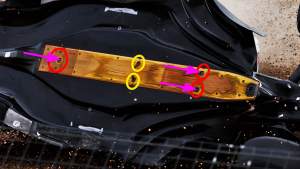Up Next

Red Bull team principal Christian Horner has warned the FIA’s mooted Formula 1 floor regulations for 2023 could lead to teams “chasing wacky aeroelastic concepts”.
Horner has criticised the planned changes since the FIA announced the intention to introduce a package of four measures designed to eliminate the porpoising and grounding problem entirely in 2023 after a meeting of the F1 Technical Advisory Committee earlier this month.
The measures are to raise the floor edges 25mm, raise the underfloor diffuser throat, introduce more stringent lateral floor deflection tests, and adopt a more accurate sensor to monitor vertical oscillations.
Horner has criticised the potential implications of the change, as well as questioning the cost consequences, and has also suggested the timing is too late – describing it as “10-past midnight” given 2023 design work is already well under way.
“Nobody wants to end up in a legal challenge, there just needs to be a bit of common sense and a bit of compromise,” said Horner when asked about the 2023 changes and the threat of teams mounting legal challenges.
“The problem is within the current regulations, you have different amounts of time available based on where you are in the championship.
“And at this late call in the day – we’re at 10 past midnight for next year – you’re looking at a fundamental change that can have significant consequences.

“There is an appetite, hopefully, for a sensible compromise. It’s not just about the raising of the floor height, or the throat height, which can have an impact into components that you wish to even carry out for next year.
“There are other tests regarding increasing the load test on the leading edge of the floor, for example.
“We don’t want to get into some aeroelastic race that, whilst the height of the floor is raised, that the elasticity becomes the flavour of the day and we all end up chasing wacky aeroelastic concepts.
“So it’s important that the whole package in its entirety is dealt with rather than cherry picking single elements.”
It should be noted that there have been suggestions certain teams have been capitalising on such aeroelasticity in their designs, in particular when it comes to the shorter-term changes to the plank regulations that will kick in at next month’s Belgian Grand Prix following suspicions certain teams are doing this to allow their cars to run lower.
In this case, the aeroelastic characteristics could be applied to allow the floor edges to run lower when at speed – something the FIA is attempting to tackle with the load test changes. However, it’s impossible to test for the full range of conditions an F1 car will experience on track.
But while Red Bull has been a vocal critic of the changes and has cast doubt over the legitimacy of the FIA’s argument that the 2023 move is for safety reasons to allow it to be pushed through without a vote, the warnings about timing are widespread.
Horner made his comments during the FIA press conference ahead of free practice on Saturday at the Hungaroring. Mike Krack and Andreas Seidl, team principals of Aston Martin and McLaren respectively, were with him and supported that aspect of his argument.
However, both teams have made it clear they are happy with the changes, so their position can be interpreted as saying not that it is too late to make the changes but that the FIA should press on with this course of action as intended.
“I don’t think there will be legal fights between the parties, I think we will find a solution as we have done with many things lately,” said Krack.
“But as Christian rightly said, it’s ten past twelve and we really need to move on.”
Seidl said that “it’s clear that time is critical, but I’m sure we will find a solution in the next weeks”.





